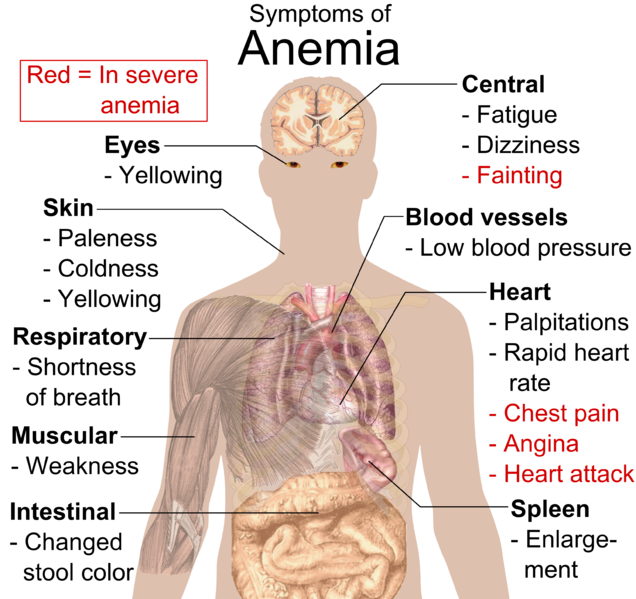Anaemia
Anaemia, also spelled anemia in American English, is a blood disorder characterized by a reduced ability of the blood to carry oxygen. This can result from a lower than normal number of red blood cells (RBCs), a reduction in the amount of haemoglobin available for oxygen transport, or abnormalities in haemoglobin that impair its function. It is derived from the Greek words "an-" meaning "not" and "haima" meaning "blood."
Signs and Symptoms

Anaemia symptoms can be variable and often non-specific, especially in mild cases. Common symptoms include fatigue, weakness, shortness of breath, dizziness, headaches, and a reduced ability to exercise. More acute or severe anaemia can lead to confusion, fainting, increased thirst, and pallor. Severe cases may result in compensatory mechanisms such as increased cardiac output, leading to palpitations, angina, and heart failure symptoms. Additional symptoms can vary depending on the underlying cause of the anaemia.
Causes
Anaemia can be caused by impaired RBC production, increased RBC destruction, blood loss, and fluid overload. Impaired production can result from deficiencies in iron, vitamin B12, or folate, bone marrow disorders, or chronic diseases. Increased destruction, or hemolytic anaemia, may be due to genetic conditions like sickle cell disease, autoimmune disorders, or infections. Blood loss can result from gastrointestinal lesions, trauma, or gynecologic disturbances. Fluid overload, particularly during pregnancy, can also cause apparent anaemia due to dilution.

Diagnosis
Anaemia is typically diagnosed through a complete blood count (CBC), which includes measurements of haemoglobin and hematocrit levels. Further testing may include serum ferritin, iron studies, vitamin B12 levels, genetic testing, and sometimes a bone marrow biopsy. The World Health Organization's thresholds for defining anaemia vary by age and gender.
Red Blood Cell Size
Anaemia can be classified by the size of red blood cells, known as the mean corpuscular volume (MCV). Microcytic anaemia (MCV < 80 fl) is often due to iron deficiency or thalassaemia. Normocytic anaemia (MCV 80-100 fl) can arise from acute blood loss or chronic diseases. Macrocytic anaemia (MCV > 100 fl) is usually due to vitamin B12 or folate deficiencies, alcoholism, or certain medications.
Treatment
Treatment for anaemia depends on the underlying cause and severity. Iron-deficiency anaemia is typically treated with oral iron supplements, though intravenous iron may be necessary in cases of poor absorption or significant deficiency. Vitamin B12 deficiency is often treated with intramuscular injections, especially in cases of malabsorption. Erythropoiesis-stimulating agents (ESAs) are used in specific conditions like chronic kidney disease. Blood transfusions are considered when haemoglobin levels are critically low, particularly in symptomatic patients.

Epidemiology
Anaemia is the most common blood disorder globally, affecting about a third of the world's population, with iron-deficiency anaemia being the most prevalent. It is particularly common in children, women of reproductive age, and the elderly. The condition is also associated with significant morbidity and mortality, particularly in sub-Saharan Africa due to infections like malaria.


Self-assessment MCQs (single best answer)
What is the primary characteristic of anaemia?
Which of the following is NOT a common symptom of anaemia?
What does a complete blood count (CBC) measure in the context of diagnosing anaemia?
Which type of anaemia is characterized by a mean corpuscular volume (MCV) of less than 80 fl?
What is a common cause of macrocytic anaemia?
Which of the following is a diagnostic test that may be used for further investigation of anaemia?
Which population is particularly at risk for iron-deficiency anaemia?
What is a common treatment for iron-deficiency anaemia?
Which of the following conditions is associated with increased RBC destruction, leading to anaemia?
What percentage of the global population is affected by anaemia?
Dentaljuce
Dentaljuce provides Enhanced Continuing Professional Development (CPD) with GDC-approved Certificates for dental professionals worldwide.
Founded in 2009 by the award-winning Masters team from the School of Dentistry at the University of Birmingham, Dentaljuce has established itself as the leading platform for online CPD.
With over 100 high-quality online courses available for a single annual membership fee, Dentaljuce offers comprehensive e-learning designed for busy dental professionals.
The courses cover a complete range of topics, from clinical skills to patient communication, and are suitable for dentists, nurses, hygienists, therapists, students, and practice managers.
Dentaljuce features Dr. Aiden, a dentally trained AI-powered personal tutor available 24/7 to assist with queries and provide guidance through complex topics, enhancing the learning experience.
Check out our range of courses, or sign up now!


